Deja vu in the 2018 playoffs.
On Monday: Mike Moustakas was 1-4. Ben Zobrist, 0-3 with a walk. Joakim Soria came on in relief to get a key third out with two men on in the 6th. Lorenzo Cain knocked in the winning run. On Tuesday: Zobrist went 1-6 and showed his defensive versatility by playing RF, LF and 2B. Second-string catcher Drew Butera entered the game in the 7th and almost became the goat of the game. With two men on and two out, a batter grounded out to end the 7th – but wait. Butera’s glove had interfered with the swing and the batter was awarded first, loading the bases. Butera got off the hook when the next hitter made the third out. In the 8th, Terrance Gore came in as a pinch runner, stole second and scurried home on a hit to tie the game. Wade Davis entered the game with two outs in the 8th. He was paired with Butera at catcher, just as they were at the end of the final game of the 2015 World Series. Davis got the third out in the 8th and allowed no runs in the 9th, sending the game into extra innings. The winning run scored in the 13th on a single by the third-string catcher who had replaced Butera.
So our Royals players are in the midst of these playoffs, but of course playing for new teams. Moose, Soria and LoCain with Milwaukee. Zobrist and Gore with the Cubs. Davis and Butera with Colorado.
The NL season ended with ties in both the West and Central Divisions. On Monday, tie-breakers were played with the Brewers beating the Cubs in the Central and the Dodgers over the Rockies in the West. This put the Rockies and Cubs in the NL Wild Card on Tuesday. The Rockies won 2-1 in 13 innings to eliminate the Cubs. The Brewers and Rockies will now play each other in the NLDS as each tries to win their first-ever World Series. The other NLDS matchup pits the Dodgers against the Braves.
I like the Rockies promo:

Rita has a soft spot for LoCain and therefore the Brewers. Below from our stadium tour this summer (at PNC in Pittsburgh).

In last night’s AL Wild Card, the Damn Yankees beat Oakland to move on to the ALDS against Boston. In the other ALDS matchup, Houston plays the Cleveland Indians. Go Tribe!
After a good second half run, the Cardinals barely missed the playoffs. The last time they were part of the postseason was 2015, which was also the year that a Cardinals executive was caught hacking into scouting databases of his former employer, the Houston Astros. This led a pundit on Twitter to say “The Cardinals haven’t made the playoffs since the Astros changed their password.” Ouch. Never fear, the Cardinals will be back.
One of the nostalgic World Series scenarios will not happen this year. The elimination of the Cubs means that there will not be a rematch of the Series teams from a century ago. More on that below.
100 Years Ago: The year was 1918. Harry Truman was leading Battery D on the battlefields of France. The Red Sox and Cubs won the AL and NL pennants and met in the World Series. And Arthur Popham opened his law office in Kansas City.
Arthur Popham was a Kentucky lawyer who moved his practice to Kansas City toward the end of World War I. He enjoyed early success in getting good verdicts for injured plaintiffs and over the years attracted other excellent trial lawyers to his firm. In 1967, when I graduated from law school, the firm’s name was Popham, Thompson, Popham, Trusty and Conway, and it was considered one of the top trial firms in the region.
I had entered law school with the intent to become a patent lawyer, combining law with my engineering degrees. After three years in law school, I got the bug to be a trial lawyer. My classmate Hollis Hanover had accepted a job offer at Popham and recommended that they also hire me. They did, and after getting my bar results in the fall, one of my first assignments was to second chair a case being tried in federal court by Mr. Popham, then 80 years old.
My primary job as second chair was to call over to the office to alert the other attorneys to come over to see the final argument. It was a master class in jury persuasion as he got a sizeable verdict in a questionable trip and fall case (reversed on appeal and later settled). It was Mr. Popham’s last jury trial. He retired sometime in the 1970’s and died in 1981. There are enough war stories about him to fill a year of Hot Stove posts.
As for me, I had the good fortune to be mentored by legendary trial attorneys Tom Conway and Tom Sweeny, two to the finest men I have ever known. The firm camaraderie was special and was celebrated each year at our “Camp Swampy” retreat at a motel near Lake Pomme de Terre (you had to be there). I tried some jury cases, winners and losers, but after 12 years it occurred to me that I was not destined for elite status in the field. So in 1979 I left what by then was called Popham, Conway, Sweeny, Fremont and Bundschu. I headed out to the Plaza to join Jim Polsinelli and some other law school friends for a new adventure. That worked out quite well, but I’ll always fondly remember my time at Popham.
I happen to be telling this story because Rita and I recently attended the 100th anniversary of what is now called The Popham Law Firm. With retirement and deaths over the years, the lawyers in the firm decided not to substitute new lawyers in the firm name, but instead embrace the Popham legacy. They kindly included alumni in the anniversary party at their beautiful offices on Broadway. It was great to see so many old friends, including the one lawyer still at Popham who overlapped my time at the firm – Dirk Vandever.
Congratulations to all at The Popham Law Firm.

[Popham Alumni Trivia: When Hollis and I joined Popham, young associates Mike Maloney and Bob Russell dumped the dregs of their dockets on to our desks. To their credit, they also taught us a lot. They both later became circuit judges. Hollis, Mike and I, along with law school classmate Walter Simpson, have a monthly lunch. Bob sometimes comes up from Warrensburg to join us. What is always obvious is that trial lawyers have better war stories than real estate lawyers. So I listen a lot. It is one of my favorite days of the month.]
The 1918 World Series – Boston Red Sox v. Chicago Cubs: As spring training started in 1918, there was some concern that there might not be a baseball season. Young men were needed for the “Great War.” Many sporting events were cancelled, including the Boston Marathon, the Indianapolis 500 and many college events. The military draft took many unmarried men from the rosters of the major league clubs. The teams moved forward with the season, but on May 23, a “work or fight” ruling by the War Department required all men of draft age to be in the military or a war-related industry by July 1. Some 80% of the players were of draft age.
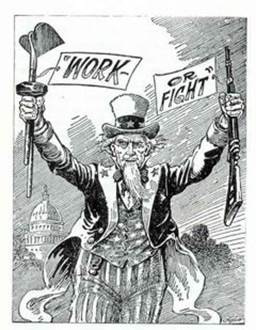
Baseball requested an exemption, but on July 19, the sport was declared nonessential by the Secretary of War. The owners desperately wanted to finish the season and so Harry Frazee led a delegation to Washington to get some relief. Frazee was the owner of the Red Sox and a Broadway producer. The War Department compromised by allowing baseball to continue if the season ended by Labor Day and the World Series by September 15. This deadline meant that the 1918 Series would become the only one ever played without any October games.
The short season ended with the Red Sox (75-51) and Chicago Cubs (84-45) as pennant winners. To cut down on travel days, the first three games of the World Series were scheduled for Chicago and the last four for Boston. The Cubs had played the season in Weeghman Park (earlier name for Wrigley Field), which at that time had a capacity of about 18,000. Hoping for a bigger attendance, the Cubs rented Comiskey Park from the White Sox (capacity 30,000).
Below is the Fenway Park “Official Score Card” for that 1918 Series. The man on the cover is Harry Frazee, the Red Sox owner who saved the season with his plea to the War Department. But not many baseball fans remember him for that. Instead, he is best known as the team owner who sold Babe Ruth to the Yankees after the 1919 season.
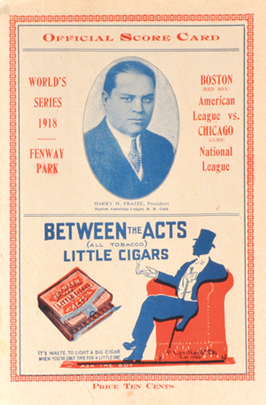
The big attendance for the Series did not materialize. A lot of baseball’s core audience, young males, were off to war. Many fans had war fatigue and some thought that the season should not even be played. The fans were also tiring of “dead-ball baseball” that featured low scoring and few home runs.
The clubs accidentally discovered a patriotic touch that spawned a new tradition. During the 7th inning stretch of Game 1, the Naval Training School Band gave in impromptu recital, and, as reported in the New York Times, “As the crowd of 19,274 spectators – the smallest that has witnessed the diamond classic in many years – stood up to take their afternoon yawn, that has been the privilege and custom of baseball fans for many generations, the band broke forth to the strains of “The Star-Spangled Banner”…The yawn was checked and heads were bared…First the song was taken up by a few, then others joined, and when the final notes came, a great volume of melody rolled across the field. It was at the very end that the onlookers exploded into thunderous applause…”.The crowd response was so strong that the teams had it played at all of the Series games.
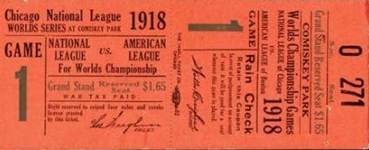
The player dominating the publicity for the Series was 23-year-old Babe Ruth. This was a transition year for the Red Sox star as he started playing the outfield on days he did not pitch. He led the league in home runs (11 – it was still the dead-ball era). He pitched Game 1 for the Red Sox and he was superb, posting a 1-0 shutout. Combined with innings from the Series in 1916, he stood at a record 22 2/3 consecutive scoreless innings.
The teams split the next two games to give Boston a 2-1 lead. Attendance for the three games in Chicago was lower than anticipated, and the players realized that their split would be much lower than the prior year. The two teams headed for Boston on the same train which also carried reporters and league officials. The players lobbied for more pay, but met strong resistance. By the time the train arrived in Boston, there was serious talk of a work stoppage.
In another piece of bad news from the train ride, Ruth injured a finger on his throwing hand. There are several stories on how that happened, but my favorite is the straw hat scenario. The 1918 Series is sometimes called the “Straw Hat Series” because the late summer start prompted many men to wear straw hats to the games. In the informal fashion world, this was inappropriate after Labor Day (time for the fedoras to come out). Ruth reportedly took some pleasure on the train enforcing the fashion rule by punching holes in the offending hats and possibly injuring his finger in the process.
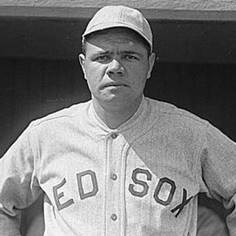
Although Ruth was clearly bothered by his injury, he toughed it out and started Game 4. He helped his own cause by knocking in two runs with a triple in the 4th inning. He pitched shutout ball for seven innings, but faltered in the 8th and allowed two runs, tying the game at 2-2. The Sox scored a run in the 8th, and reliever Bullet Joe Bush pitched the 9th for the save. Ruth got credit for the win to go 2-0 for the Series. His consecutive scoreless streak ended at 30 2/3 innings, a Series record that stood until fellow Yankee Whitey Ford went 33 2/3 scoreless innings in the early 1960’s.
Game 5 almost did not get played. The players were still unhappy and threatened to walk out. The negotiations that started on the train continued at the stadium, but no progress was made. American League President Ban Johnson was not much help because he was reportedly “hopelessly drunk.” The game was set to start at 2:30, and by 3:00, the fans were shouting “Bolsheviks” and “shameless holdups.” The players relented, saying they would do so for the sake of the public and the soldiers and sailors. The decision to play was announced through a megaphone by former Boston Mayor John “Honey Fitz” Fitzgerald, the grandfather of then one-year old John F. Kennedy.
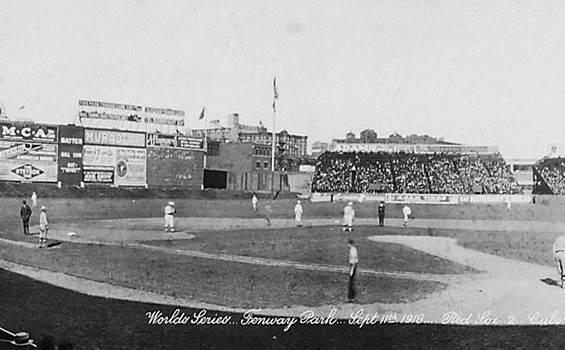
The Cubs won Game 5, but Boston took Game 6 to win the Series 4 games to 2. The Series has been described as “joyless.” Fans were distracted by the war. The Red Sox players each got $1,102, the lowest winning share in Series history (in 1917, the number was $3,669). The labor leverage that favored the owners would remain until Marvin Miller organized the players in the 1960’s. As for baseball in the coming year, It was assumed that the season would be cancelled because of the war. But the early armistice in November of 1918 allowed the 1919 season to start on time (and end with the Black Sox scandal).
Both the Cubs and Red Sox were successful in early World Series history. The Red Sox won five Series, including the very first (1903, 1912, 1915, 1916 and 1918) and the Cubs two (1907 and 1908). And then came the droughts. The Red Sox did not win again until 2004 (86-year drought). The Cubs did not win again until 2016 (108-year drought).
Of course we know why the Red Sox went downhill. The Curse of the Bambino. Ruth enjoyed the accolades he got for hitting home runs and in 1919 boosted his total to 29 (still the dead-ball era). But Harry Frazee had tired of Ruth’s antics and demands. He also needed money to keep his Red Sox playing (and maybe to help fund a Broadway show), so he sold Ruth to the Yankees after the 1919 season. What timing.
The Series of 1918 had been won by the Red Sox scoring only 9 runs in six games. The lack of scoring was turning off fans and so baseball started looking for more offense. They found it with batter-friendly rules that started the “live-ball” era in 1920 – not really a change in the construction of the ball, but how the balls were used – the balls would now be replaced at the first sign of wear so the balls would not get soft (which reduced impact) or dirty (harder to see). Additionally, the leagues started a process to prohibit pitchers from scuffing or applying foreign substances to the ball. Ruth responded in 1920 by hitting 54 homers in his first year with the Yankees. The Red Sox, sans Ruth, fell into oblivion.
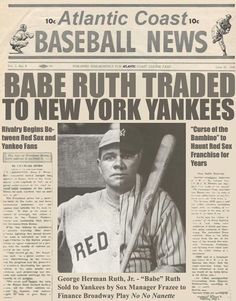
Ruth was of course much more than the homers. Sportswriter Roger Angell has called Ruth “the model for modern celebrity” – and this is a perfect segue to talk about a new Babe Ruth book.
Jane Leavy and Babe Ruth at Rainy Day Books: Steve Fehr introduced me to author Jane Leavy by giving me a copy of her book Sandy Koufax: A Lefty’s Legacy. It is a great biography, and Leavy followed up with another best-selling bio, The Last Boy: Mickey Mantle and the End of America’s Childhood. I have also read her hilarious novel Squeeze Play.
Leavy’s new book The Big Fella: Babe Ruth and the World He Created will be released on October 16. She already got some good publicity by taking the mound and throwing out the first pitch at Yankee Stadium on September 21. Please mark your calendar: Leavy will be in Kansas City at Rainy Day Books on October 24. Details are here.
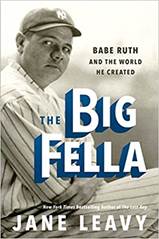
I can’t wait to start reading. Here’s a taste of what to expect:
“He lived in the present tense – in the camera’s lens. There was no frame he couldn’t or wouldn’t fill. He swung the heaviest bat, earned the most money, and incurred the biggest fines. Like all the new-fangled gadgets then flooding the marketplace – radios, automatic clothes washers, Brownie cameras, microphones and loudspeakers, Babe Ruth ‘made impossible events happen.’ Aided by his crucial partnership with Christy Walsh – business manager, spin doctor, damage control wizard, and surrogate father, all stuffed into one tightly buttoned double-breasted suit – Ruth drafted the blueprint for modern athletic stardom.”
See you at Rainy Day (note, this is at the store, not at Unity on the Plaza).
Lonnie’s Jukebox: As might be suspected, I have no rock ‘n’ roll prospects from 1918. But I do have a story from those times that leads to one of the great rock ‘n’ roll ballads.
Charles Dawes was a banker and an active Republican. He served in World War I from 1917 to 1919, rising to the rank of brigadier general. After the war, he was appointed to positions in the Warren Harding administration, most notably as a member of the Allied Reparations Commission. His work on the “Dawes Plan” helped Germany stabilize its economy and led to Dawes sharing the 1925 Nobel Peace Prize. He served as Vice President to Calvin Coolidge from 1925 to 1929.
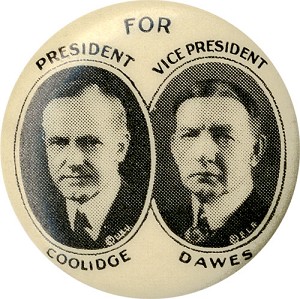
Dawes was also a self-taught pianist and composer. In 1911, he wrote an instrumental piece called “Melody in A Major,” and it became a well-known piano and violin song. In 1951, Carl Sigman added lyrics to the music. In 1958, during the first semester of my senior year in high school, I bought a 45-rpm record that had merged Dawes composition with the Sigman lyrics: Tommy Edwards singing “It’s All in the Game.” The record was #1 for six weeks.
More trivia: Dawes is the only vice president with a #1 hit. Dawes and Bob Dylan are the only Nobel Prize winners to have a #1 hit.
The song is not about the game of baseball. Listen here.
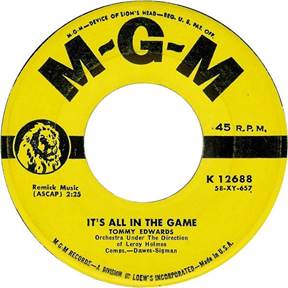
One thought on “Hot Stove #83 – A Century of Baseball – The 2018 Playoffs and the World Series of 1918”
Comments are closed.